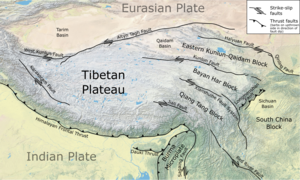1973 Luhuo earthquake
| UTC time | 1973-02-06 10:37:10 |
|---|---|
| ISC event | 763709 |
| USGS-ANSS | ComCat |
| Local date | February 6, 1973 |
| Local time | 18:37 CST[1] |
| Magnitude | Ms 7.6[2] |
| Depth | 11 km (6.8 mi)[3] |
| Epicenter | 31°23′53″N 100°34′52″E / 31.398°N 100.581°E |
| Fault | Xianshuihe fault system |
| Type | Strike-slip |
| Areas affected | China |
| Max. intensity | MMI X (Extreme) |
| Landslides | Yes |
| Aftershocks | Ms 6.3[2] |
| Casualties | 2,175–2,204 dead, 2,743 injured |
The 1973 Luhuo earthquake struck near the town of
Tectonic setting

Western
Earthquake

The Xianshuihe fault system is a 1,400 km (870 mi) long active left-lateral strike-slip fault that accommodates the strike-slip motion in the Tibetan Plateau. The fault is one of the largest active intracontinental geological structure in the world. Since 1893, at least 350 km (220 mi) of the fault length has ruptured in large successive earthquakes with magnitudes 6.5 or larger.[7] From 1700 to the present-day, the fault has ruptured its entire length during large earthquakes.[8]
The earthquake measured 7.9 on the Chinese
The Luhuo segment of the Xianshuihe fault system was also the source of a magnitude 7.5 earthquake in 1816. Field research through trenching at the Luhuo segment however, revealed a record of earthquake history on the fault in the past 3,000 years. The first event identified in the exposed strata layers corresponded to the year 769 BC. Five additional events were also identified to have occurred in the years 318–545 AD, 677–833 AD, and 1008–1444 AD. A recurrence interval has been calculated at between 157 and 1,200 years for the earthquakes from 769 BC–1973 AD.[14]
A Ms 6.3
Impact
The earthquake killed between 2,175 and 2,204 people in
Response
A division of the People's Liberation Army was sent to the affected area to assist in rescue and recovery efforts. In the division, at least 668 medical crew from 49 groups attended to injured survivors.[20]
See also
References
- ^ a b Utsu, T. "Search Page". Catalog of Damaging Earthquakes in the World (Through 2008). Retrieved June 3, 2010.
- ^ a b c Liu Guiping; Fu Zhengxiang. "1973年炉霍大地震(Ms=7.6)最大余震(Ms=6.3)的库仑破裂应力触发" [The Coulomb rupture stress triggering of the largest aftershock (Ms=6.3) of the 1973 Luhuo earthquake (Ms=7.6)]. Earthquake Research in China (in Chinese). 18: 175–182. Retrieved 23 July 2021.
- ^ .
- doi:10.7289/V5TD9V7K. Retrieved 5 January 2023.
- S2CID 134590278. Retrieved 19 July 2021.)
{{cite journal}}: CS1 maint: multiple names: authors list (link - .
- S2CID 129325246.
- .
- ^ a b c Clarence R. Allen; Luo Zhuoli; Qian Hong; Wen Xueze; Zhou Huawei; Huang Weishi (1989). "Segmentation and Recent rupture history of the Xianshuihe Fault, Southwestern China". U.S. Geological Survey Open-file Report. Fault segmentation and controls of rupture initiation and termination. (89–315): 10–30. Retrieved 2 July 2021.
- ^ . Retrieved 2 July 2021.
- doi:10.1785/BSSA07306A1585.)
{{cite journal}}: CS1 maint: multiple names: authors list (link - ^ .
- ^ "M 7.0 – 184 km NW of Kangding, China". earthquake.usgs.gov. USGS. Retrieved 2 July 2021.
- .
- ^ "M 5.8 – 227 km NW of Kangding, China". earthquake.usgs.gov. USGS. Retrieved 23 July 2021.
- ^ Yang Yanyu, ed. (6 February 2013). "四川炉霍40年从地震废墟上崛起". China News. Retrieved 2 July 2021.
- ^ Li Zhongdong (25 February 2019). "鲜水河断裂带,危险与美景并存之地". 163.com. Archived from the original on 9 July 2021. Retrieved 2 July 2021.
- ^ a b "1973年炉霍地震". Archived from the original on 2020-02-22. Retrieved 2013-08-13.
- ^ "大灾无情!盘点历史上四川发生的10余次7级以上地震". chengdumingxiao.com. 10 August 2017. Retrieved 2 July 2021.
- ^ "四川炉霍40年从地震废墟上崛起" (in Chinese). China News Network. 2013. Retrieved 23 July 2021.
External links
- The International Seismological Centre has a bibliography and/or authoritative data for this event.
- 【记忆中的年】四十八年前的春节 – Images of the earthquake

